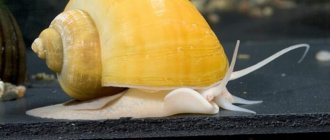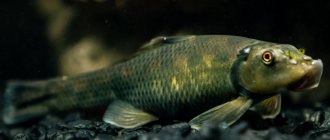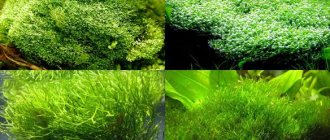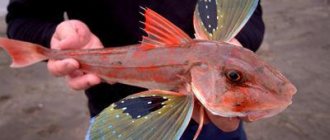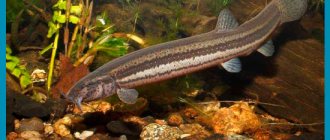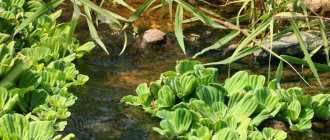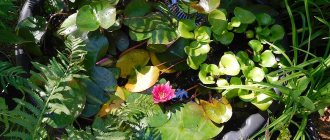Aulophorus are transparent or reddish net worms, the size of which varies from 10–20 mm, and the thickness is 0.2 mm. The species was recorded by Müller in 1773.
Another name for this species is water snake. A characteristic feature is that individuals swim in a spiral motion and gather in tangled piles. Their natural habitat is silted ponds and reservoirs, where they feed on rotting algae, dead parts of plants and other organic matter.
Aulophorus is a good food for fish and aquatic animals such as frogs and salamanders. Due to its nutritional value, it is often used to feed fry. The species will not pollute the water in the aquarium: use it as an addition to the recreation of the ecosystem.
Description
Aulophorus furcatus belongs to the annelids of the naidid family.
These pink worms have a body length of no more than 2 cm and a thickness of 0.2 mm. Aulophorus lives in shaded areas of fresh water bodies rich in organic remains of rotting plants, fallen leaves, branches, tree bark, etc. In the absence of predators, Aulophorus worms reproduce quickly and in large numbers. Attention! If you don't know where to get aulophorus, you can order it by mail. The cost of a worm culture is 450 rubles , excluding postage. You can find out the cost of shipping, as well as the delivery time of the parcel, by following the link: https://www.pochta.ru/parcels (copy the link and paste it into the address bar of your browser) or tell me your address and I will tell you the delivery time and full postage cost. Transporting aulophorus in a parcel for 3 weeks is safe. To order a parcel with aulophorus, you need to inform me by email and I will send you the order conditions. I will inform you of the postal ID number immediately after sending the parcel, and I will also provide detailed instructions for unpacking the parcel and transferring the aulophorus to a new container.
Live food Aulophorus (water snake)
Aulophorus are transparent or reddish net worms, the size of which varies from 10–20 mm, and the thickness is 0.2 mm. The species was recorded by Müller in 1773.
Another name for this species is water snake. A characteristic feature is that individuals swim in a spiral motion and gather in tangled piles. Their natural habitat is silted ponds and reservoirs, where they feed on rotting algae, dead parts of plants and other organic matter.
Aulophorus is a good food for fish and aquatic animals such as frogs and salamanders. Due to its nutritional value, it is often used to feed fry. The species will not pollute the water in the aquarium: use it as an addition to the recreation of the ecosystem.
Breeding Aulophorus at home
There are two ways to breed Aulophorus. In the first, water snakes are bred in water in some container, for example, an aquarium. In the second method, which is considered the simplest known and popular, aulophoruses are bred in a semi-aquatic environment on a foam sponge where the protruding part of the sponge remains 2-3 mm unflooded with water.
The sponge is placed in a small container, for example, in a plastic ice cream jar, always with a closing lid, in which several small holes are made to allow air to enter, and the walls of the container are covered with light-proof paper or film to maintain darkness in it.
Introduction
Keeping aquarium fish is a fascinating process, from choosing residents and plants to maintaining comfortable living conditions. Many owners of miniature copies of seas and oceans know that even fish food can become a pet! It sounds strange, but promising. Aulophorus in an aquarium is an excellent food crop that even a beginner can breed. In this article we will tell you in detail about who “water snakes” are and what mistakes should not be made when growing them.
What to feed Aulophorus
The following can be used to feed Aulophorus: spirulina, grass flour, pieces of boiled carrots, zucchini, cabbage, banana peels, etc. But according to my observations, Aulophorus worms adore oatmeal most of all. Oatmeal is not often found on sale, but if desired, you can prepare it yourself from rolled oatmeal flakes by grinding them in a coffee grinder.
Note: you can grind oatmeal with a manual meat grinder. Having poured 2-3 tablespoons of oatmeal into the meat grinder, you need to cover the holes of the grate with your palm so that the flakes do not come out unground and by making a few turns with the handle, you can open the grate slightly and thus get ready-made flour at the output, which, if necessary, can be cleaned of large particles by sifting through a sieve.
Aulophorus should be fed in small portions, scattering the food over the surface of the sponge. It is necessary to re-apply food only when it is completely or almost completely eaten. If the food uses oatmeal or spirulina, you can sprinkle them in small piles in the center or in different places of the sponge.
On a wet surface, flour and spirulina quickly become soggy and become accessible to worms. Aulophorus worms gather around the food and gradually eat it. As the worms breed, they eat the food faster and feeding needs to be repeated more often.
How to get rid of hydra in an aquarium?
It all depends on the size of the hydra population and the species composition of your aquarium. Gourami, as well as other labyrinths: cockerels, macropods, laliuses eat hydras, and can cope with a small population on their own. If there are a lot of hydras, in our opinion, the best way out is to resort to modern achievements in aquarium husbandry, special anti-hydra preparations, such are in the product line of all well-known manufacturers of aquarium chemicals, most often such preparations are made on the basis of heavy metals, for example, copper, but many years of experience and numerous tests have allowed scientists to create drugs that can kill hydras without harming the fish.
There are other ways, one of them is to add salt to the water, calculating the dose so that the aquarium produces a 0.5% saline solution. This curbs the growth of the hydra population; you remember what happens to various slugs if you sprinkle salt on them? But keep in mind that before using this method, you need to make sure that all other inhabitants of your aquarium can tolerate a similar level of salinity.
And finally, 2 very extreme methods: temporarily relocate all the fish, and for an hour raise the temperature in the aquarium above 42 degrees Celsius, the hydra should die, but keep in mind that not all beneficial bacteria tolerate such a temperature, and such an aquarium bath, with with a high degree of probability it will affect the biological balance in it.
The last method can be compared to nuclear bombing; you should resort to it when absolutely nothing helps - this is a complete restart of the aquarium, with draining all the water, washing the walls, boiling the soil and decorations, and other horrors.
Mistakes when breeding Aulophorus
In order to avoid mistakes when breeding aulophoruses that can lead to the loss of the worm culture, there are important features that need to be discussed separately. Let's start with the air holes in the lid of the container. It is important that the holes are of the smallest diameter (they can be made with a thin awl or a large sewing needle), otherwise food competitors may settle in the container, for example, fruit flies, which will not be easy to get rid of.
Note: Once I opened the lid of the container, I noticed several fruit flies flying out of it. Later, fruit fly larvae appeared among the Aulophorus culture, and the culture itself began to noticeably fade away. I immediately changed the lid of the container, but I had to spend more than one day to get rid of the larvae. Every day I picked them out with tweezers and fed them to the fish.
The second important point is the water and its level in the container. Aquarium water is better suited for breeding Aulophorus, and you need to pour it into the container so much that the protruding part of the sponge remains 2-3 mm unflooded with water. Aulophorus worms live in sponges, filling its microscopic voids, but they go to the surface not covered with water to feed.
Aulophorus is not bred
Insects can cause the death and cessation of development of aulophoruses. The period of active emergence of fruit flies begins in summer and ends with the last harvests of autumn. The bait for them is fruits, especially rotten ones, and the smell of fermentation.
Making their way into the container, fruit flies lay larvae in the substrate. They, in turn, begin to suppress the Aulophorus culture. This is easy to notice: when you open the lid, frightened flies will begin to fly out of the container en masse.
Unfortunately, there are few methods of protection. Firstly, it is worth preventing flies from getting into the container. To do this, cover the lid with gauze or other mesh covering.
If the worm culture is already colonized by flies, you will have to collect all the larvae. This is best done with tweezers.
Aulophorus has a strong smell
Over time, the water and sponge become contaminated with the worms' metabolic products and an unpleasant odor emanates from the container. Caring for Aulophorus involves partially washing the sponge and completely changing the water in the container. The procedure is very simple.
If a lot of worms have accumulated on the surface of the sponge, you need to temporarily remove them with tweezers, rinse the sponge in tap or aquarium water with periodic gentle squeezing, then put the sponge in a container, return the worms, pour in fresh aquarium water, add food and close the container.
Very often, after washing the sponge, a lot of worms remain in the water. The water in which the sponge was washed can be filtered through a net made of fine fabric, and the worms remaining in the net can be returned to a container or fed to the fish.
Artemia salina
Artemia lives in salty waters. The dry matter of Artemia contains 42-48% protein. 17 amino acids were found in it. For fish farming purposes, decapsulated Artemia eggs are used. Sometimes nauplii are obtained from eggs. All these feed products are used to raise fish larvae.
Decapsulated eggs can be prepared for future use. To do this, they are dried and stored. Shelf life is several months.
Obtaining nauplii
Their eggs in a 4% solution of table salt are placed in an incubator. At a water temperature of 26 degrees and air bubbling, nauplii hatching occurs after 48 hours. The nauplii in the apparatus are in the lower layers, and the egg shells float to the surface. Therefore, separating nauplii from debris is quite simple - by draining the lower layers into special containers. In this case, the hatching of nauplii is 30-50% of the laid eggs.
In addition to breeding living organisms for feeding fish, there are ways to obtain live food from natural fishless reservoirs. Gammarus, higher aquatic vegetation and phytoplankton, sapropel, and cladoceran crustaceans are harvested.
Where to catch Aulophorus
You can catch Aulophorus for breeding at home in a natural reservoir. It is not difficult to determine the body of water in which aulophoruses live. As a rule, fish are not found in such reservoirs. It is littered with branches and snags, and the coastal part is overgrown with grass. To catch aulophoruses, you can make a special trap.
The design of the trap is quite simple and can consist of a glass jar with a closing lid, in which it is necessary to make holes through which the aulophorus could penetrate to feast on the bait. You can use banana peels, carrot or cabbage peelings, etc. as bait.
A rope is tied to the trap and thrown into the coastal part of the reservoir for several days. A few days later, the trap is removed, and the bait on which the Aulophorus worms should settle is rinsed in clean water from another container. The worms that have settled to the bottom of the jar curl up into balls, which will need to be removed with tweezers and placed in a container on a foam sponge for further breeding.
At first, the aulophoruses hide in the sponge, apparently this is due to their adaptation to their new place of residence, but after a few days the worms begin to come to the surface to actively feed and reproduce.
Duckweed
Duckweed reproduces mainly by vegetative means. One mother plant produces up to 20 daughter plants. Duckweed survives winter in the form of special buds that sink to the bottom, where they remain dormant until spring. Some species bloom in sunny weather. The seeds formed during cross-pollination survive temporary drying of the reservoir.
In the reservoirs of our country there are four types of duckweed: small, three-lobed, humpbacked and multi-rooted.
Duckweed reproduces very quickly, producing huge yields of green mass per unit area of the reservoir. According to some data, the average daily growth of duckweed is 15% of the total mass.
Duckweed is characterized by a high protein content, which is higher than in clover or alfalfa. On average, duckweed contains 25% protein, clover – 19%, and alfalfa – 18%.
Duckweed is a valuable food for fish. It is given in the form of a paste as fish feed (4%).
How to feed fish with Aulophorus
The ease of cultivating aulophoruses is not their only advantage. It is also convenient that these worms do not need to be washed, like the well-known nematode microworms, for example, and the feeding process itself is very simple: open the lid of the container, take a certain number of worms with tweezers and transfer them to an aquarium with fish.
Aulophorus is well eaten by all fish, but since the worms fall to the bottom and curl into balls, it is primarily accessible only to bottom-dwelling fish. To evenly distribute the worms throughout the aquarium, the balls of worms must first be broken up by placing them in a test tube or bottle of water, then shake well and only then pour them into the aquarium.
Subtleties of content
Despite the primitiveness of the species, take into account some of the subtleties of keeping it so that Aulophorus becomes a real delicacy for the inhabitants of the aquarium. They are valued as food and natural sanitation workers.
Place the grown specimens in a small aquarium where the water height will reach 20 cm. Good aeration will help maintain the vital activity of the snakes. The ideal option would be an improvised feeder: stretch gauze over a foam frame. You can place pumpkin pulp, nettles, carrots, bananas or melon (pulp) on it. Serve them fresh or dried, soaked before feeding.
For hard vegetables such as carrots, peel and place them in the freezer first. Before feeding, scald the vegetable with boiling water and place it in a bowl of water for a day.
This is necessary so that you can easily remove the skin of the vegetable, thereby making feeding easier and preventing the growth of bacteria. Protein in the form of low-fat cottage cheese or eggs will be a useful addition to the mixture.
Aquarists have developed the ideal food formula:
- 300 grams of clover;
- 100 grams of brewer's yeast;
- 100 grams of carrots;
- 5 grams of daphnia;
- 2 grams of mineral fertilizers;
- 5 glucose tablets.
Place the ingredients in a blender and grind into a paste. Next, add water and stir the mixture to a dough consistency. The product can be stored in the refrigerator.
Change up to 70% of the water daily. If the worms clump together and begin to float or attach to the walls of the vessel, this indicates insufficient aeration and contamination.
Due to weak aeration, the floating aulophorus will quickly die. Every day it is necessary to remove 20% of worms from the dishes, since this procedure stimulates their reproduction.
Feeding the fry
Typically, Aulophorus worms are not used as starter food, but for fry of fish species such as swordtails, platies and mollies, it becomes sized within a week. If necessary, the worms can be cut with a sharp blade on a piece of rubber or glass.
It is believed that the extra cut aulophorus does not die and does not spoil the water because each piece is alive and has the property of being restored into a separate individual. If anyone doesn’t know, earthworms also have the same property. The fry of Aulophorus worms adore them and grow very quickly on them.
=Uninvited guests in the aquarium or identification of krakozyabry!=
Who got into the aquarium?
Every aquarist at least once in his life is faced with a situation when uninvited inhabitants are found in his favorite aquarium, which the aquarist did not populate. These can be various snails, crustaceans, worms, coelenterates and other living creatures.
Let's figure out how they get into the aquarium, whether you should be afraid of any of them, and what methods of dealing with them exist.
A postulate that I want to say right away, since it is true for almost all uninvited guests: if they begin to actively reproduce, you are overfeeding the fish or you simply haven’t cleaned the aquarium for a long time.
Also, before starting to identify “aquarium reptiles”, it is worth talking about the general scheme of how to deal with and get rid of them. The first thing you need to do is clean the aquarium: siphon the soil, wipe the walls of the aquarium, clean the filter. Then you should use one or another remedy for the “parasite”, many of which do not tolerate any medications, i.e. you can pour in the same Tetra Contralk, if it is available, and this will be enough for many simple organisms. But you should still understand the nature of the uninvited guest. If these are worms, then you need to use an anthelmintic drug, for example, aquarists often recommend using veterinary Febtal for planaria; pharmaceutical Nemozol 400 ml also copes well with these tasks. If it is a fungus, then you need a fungicidal agent, for example, Tetra FungiStop.
It should also be understood that most unidentified guests are safe for the aquarium and are an excellent food source for fish. Basic aquarium care can level out their numbers.
Now let’s get down to answering the question: what’s in the aquarium?!
Where to buy Aulophorus culture
Well, we have come to the final part of my publication. I am sure that I was able to convince you that Aulophorus is a valuable food for breeding at home, and your fish deserve to eat it. But where can you buy an Aulophorus culture? They certainly don’t sell Aulophorus in pet stores, but you can get it at the bird market among experienced aquarists.
You can order Aulophorus by mail via the Internet, but given that the worm culture is delicate, there is no one hundred percent guarantee that it will reach its destination and not die. This can be evidenced by numerous customer responses. By the way, I decided to conduct a series of experiments on the survival of Aulophorus worms in various conditions associated with long-term transportation in summer and winter. I will definitely report the results in my publications.
Advantages and disadvantages
The water snake is very useful for the inhabitants of the underwater world. Feed value of Aulophorus in% of dry weight: protein - 60, fats - 11, carbohydrates - 7.2. However, it should not form the basis of the diet: aulophorus is best used as a balanced complementary food. This species can be found on the shelves of many pet stores and costs little money. It is also used as an aquarium orderly.
If the fish do not eat all the worms, the aulophorus will retain its vital activity.
It is worth considering that cut aulophorus is capable of regenerating, and new worms will then grow from the “pieces”.
However, despite all this, breeding at home requires some effort and can be marred by an unpleasant odor and the appearance of flies.
Aulophorus is a popular live food species. Unlike most other complementary foods, it helps prevent siltation in the aquarium. These are highly productive organisms that can quickly accumulate weight. Thus, the doubling of mass at a temperature of 26 degrees occurs after 4 days. The big advantage is that breeding snakes at home does not require expensive equipment, and your fish will be grateful for such tasty and nutritious food.
Planaria (Dendrocoellum lacteum) in an aquarium
Planaria (Dendrocoellum lacteum) in an aquarium photo
Flatworms, covered with small hairs, have poisonous glands, which is why most fish cannot feed on them. They can get into the aquarium in any way: water, new plants, new soil, poorly processed live food, etc. They can reach enormous sizes of several centimeters. Capable of being restored to full size from a piece not exceeding 0.5% of the original body. They eat everything that gets into their mouth, from snail eggs to shrimp and small fish. To combat planaria, special traps are produced, into which a certain delicacy is placed, beef heart, for example. Since the planaria is nocturnal, we “load” the trap in the evening, and in the morning we take out the catch, methodically repeating these actions until we survive the enemy from our territory. If this gentle method does not help, you will have to resort to chemical attack with specially developed drugs. Febtal and Nemazol cope well with planaria. Practice with nemazole in the comments under the article.
Snail coils
Snail coil photo
We can say with confidence that 100% of aquarists have encountered these small snails, colored from brown to red, in their practice. Most often they are introduced in the form of eggs with plants or decorations that are purchased. These snails are extremely prolific, and if favorable conditions are created for them: excess food, hard water, not very clean water and algae on the glass, you risk getting a real invasion of these snails. In general, they are harmless, but when they are located throughout the aquarium in large clusters, it is extremely unaesthetic, would you agree?
Control methods are simple - no overfeeding, clean water. If the coils do multiply, you can remove them manually, you can prepare various traps for them, the most primitive is a cucumber; several dozen individuals gather on half a cucumber during the night. The best and most natural, in my opinion, method of control, as with acrolux snails, is Helena snails. Well, if nothing helps at all, and you want to remove the coils quickly, use chemicals according to the instructions, but again, remove the noble snails so that they do not suffer.
